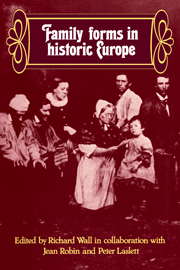Book contents
- Frontmatter
- Contents
- List of contributors
- Preface
- 1 Introduction
- 2 Two kinds of pre-industrial household formation system
- 3 ‘A large family: the peasant's greatest wealth’: serf households in Mishino, Russia, 1814–1858
- 4 The peasant family as an economic unit in the Polish feudal economy of the eighteenth century
- 5 The familial contexts of early childhood in Baltic serf society
- 6 Estonian households in the seventeenth and eighteenth centuries
- 7 Family and familia in early-medieval Bavaria
- 8 The property and kin relationships of retired farmers in northern and central Europe
- 9 Pre-industrial household structure in Hungary
- 10 The reconstruction of the family life course: theoretical problems and empirical results
- 11 The changing household: Austrian household structure from the seventeenth to the early twentieth century
- 12 Does owning real property influence the form of the household? An example from rural West Flanders
- 13 The evolving household: the case of Lampernisse, West Flanders
- 14 The composition of households in a population of 6 men to 10 women: south-east Bruges in 1814
- 15 The importance of women in an urban environment: the example of the Rheims household at the beginning of the Industrial Revolution
- 16 The household: demographic and economic change in England, 1650–1970
- 17 Family and household as work group and kin group: areas of traditional Europe compared
- References
- Index
13 - The evolving household: the case of Lampernisse, West Flanders
Published online by Cambridge University Press: 05 November 2011
- Frontmatter
- Contents
- List of contributors
- Preface
- 1 Introduction
- 2 Two kinds of pre-industrial household formation system
- 3 ‘A large family: the peasant's greatest wealth’: serf households in Mishino, Russia, 1814–1858
- 4 The peasant family as an economic unit in the Polish feudal economy of the eighteenth century
- 5 The familial contexts of early childhood in Baltic serf society
- 6 Estonian households in the seventeenth and eighteenth centuries
- 7 Family and familia in early-medieval Bavaria
- 8 The property and kin relationships of retired farmers in northern and central Europe
- 9 Pre-industrial household structure in Hungary
- 10 The reconstruction of the family life course: theoretical problems and empirical results
- 11 The changing household: Austrian household structure from the seventeenth to the early twentieth century
- 12 Does owning real property influence the form of the household? An example from rural West Flanders
- 13 The evolving household: the case of Lampernisse, West Flanders
- 14 The composition of households in a population of 6 men to 10 women: south-east Bruges in 1814
- 15 The importance of women in an urban environment: the example of the Rheims household at the beginning of the Industrial Revolution
- 16 The household: demographic and economic change in England, 1650–1970
- 17 Family and household as work group and kin group: areas of traditional Europe compared
- References
- Index
Summary
Lampernisse: economy and household structure
Lampernisse is a small village in the canton of Pervijze (see fig. 12.1, p. 383). Before the French occupation in 1796 it was one of the villages of the region known as Veurne-Ambacht. Its population under the Ancien Régime was quite stable at around 210 persons, but after the French occupation which ended in 1815 the number of inhabitants rose steadily from about 350 to a maximum of 462 in 1846. According to van der Maelen, writing in 1836, the same range of crops (wheat, rye, oats, barley, oil-producing plants, vegetables, and fruit) was to be found in Lampernisse as elsewhere in West Flanders.
Studies by Dalle have illuminated certain structural elements of the West Flanders society of which Lampernisse forms a small part. Dalle found, for example, that the majority of servants outside the town of Veurne were male (sex ratio 144). Male children over 12 outnumbered female children, although not to such a marked extent (sex ratio 107). But we know nothing of the role of kinship in the household beyond the nuclear family, nor has it been possible to throw any light on the process by which offspring succeeded their parents as heads of households. One list on its own may show the place of the old and of the young in the household, but it cannot tell us how individuals moved from one position to another, nor what other opportunities they might have taken up had they wished or the occasion demanded.
- Type
- Chapter
- Information
- Family Forms in Historic Europe , pp. 409 - 420Publisher: Cambridge University PressPrint publication year: 1983
- 1
- Cited by



